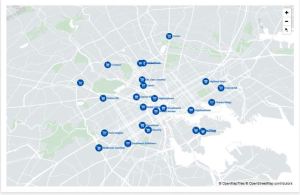By Sam Whitehead and Arthur Allen | KHN
Gwyneth Paige didn’t want to get vaccinated against covid-19 at first. With her health issues — hypertension, fibromyalgia, asthma — she wanted to see how other people fared after the shots. Then her mother got colon cancer.
“At that point, I didn’t care if the vaccine killed me,” she said. “To be with my mother throughout her journey, I had to have the vaccination.”
Paige, who is 56 and lives in Detroit, has received three doses. That leaves her one booster short of federal health recommendations.
Like Paige, who said she doesn’t currently plan to get another booster, some Americans seem comfortable with the protection of three shots. But others may wonder what to do: Boost again now with one of the original vaccines, or wait months for promised new formulations tailored to the latest, highly contagious omicron subvariants, BA.4 and BA.5?
The rapidly mutating virus has created a conundrum for the public and a communications challenge for health officials.
“What we’re seeing now is a little bit of an information void that is not helping people make the right decision,” said Dr. Carlos del Rio, a professor of infectious diseases at the Emory University School of Medicine.
Del Rio said the public isn’t hearing enough about the vaccines’ value in preventing severe disease, even if they don’t stop all infections. Each new covid variant also forces health officials to tweak their messaging, del Rio said, which can add to public mistrust.
About 70% of Americans age 50 and older who got a first booster shot — and nearly as many of those 65 and older — haven’t received their second covid booster dose, according to data from the Centers for Disease Control and Prevention. The agency currently recommends two booster shots after a primary vaccine series for adults 50 and older and for younger people with compromised immune systems. Last week, multiple news outlets reported that the Biden administration was working on a plan to allow all adults to get second covid boosters.
Officials are worried about the surge of BA.4 and BA.5, which spread easily and can escape immune protection from vaccination or prior infection. A recent study published in Nature found BA.5 was four times as resistant to the currently available mRNA vaccines as earlier omicron subvariants.
Consistent messaging has been complicated by the different views of leading vaccine scientists. Although physicians like del Rio and Dr. Peter Hotez of Baylor College of Medicine see the value in getting a second booster, Dr. Paul Offit, a member of the FDA’s vaccine advisory committee, is skeptical it’s needed by anyone but seniors and people who are immunocompromised.
“When experts have different views based on the same science, why are we surprised that getting the message right is confusing?” said Dr. Bruce Gellin, chief of global public health strategy at the Rockefeller Foundation and Offit’s colleague on the FDA panel.
Janet Perrin, 70, of Houston hasn’t gotten her second booster for scheduling and convenience reasons and said she’ll look for information about a variant-targeted dose from sources she trusts on social media. “I haven’t found a consistent guiding voice from the CDC,” she said, and the agency’s statements sound like “a political word salad.”
On July 12, the Biden administration released its plan to manage the BA.5 subvariant, which it warned would have the greatest impact in the parts of the country with lower vaccine coverage. The strategy includes making it easier for people to access testing, vaccines and boosters, and covid antiviral treatments.
During the first White House covid briefing in nearly three weeks, the message from top federal health officials was clear: Don’t wait for an omicron-tailored shot. “There are many people who are at high risk right now, and waiting until October, November for their boost — when in fact their risk is in the moment — is not a good plan,” said Dr. Rochelle Walensky, head of the CDC.
With worries about the BA.5 subvariant growing, the FDA on June 30 recommended that drugmakers Pfizer-BioNTech and Moderna get to work producing a new, bivalent vaccine that combines the current version with a formulation that targets the new strains.
The companies both say they can make available for the U.S. millions of doses of the reformulated shots in October. Experts think that deadline could slip by a few months given the unexpected hitches that plague vaccine manufacturing.
“I think that we have all been asking that same question,” said Dr. Kathryn Edwards, scientific director of the Vanderbilt Vaccine Research Program. “What’s the benefit of getting another booster now when what will be coming out in the fall is a bivalent vaccine and you will be getting BA.4/5, which is currently circulating? Although whether it will be circulating in the fall is another question.”
The FDA on July 13 authorized a fourth covid vaccine, made by Novavax, but only for people who haven’t been vaccinated yet. Many scientists thought the Novavax shot could be an effective booster for people previously vaccinated with mRNA shots from Pfizer-BioNTech and Moderna because its unique design could broaden the immune response to coronaviruses. Unfortunately, few studies have assessed mix-and-match vaccination approaches, said Gellin, of the Rockefeller Foundation.
Edwards and her husband got covid in January. She received a second booster last month, but only because she thought it might be required for a Canadian business trip. Otherwise, she said, she felt a fourth shot was kind of a waste, though not particularly risky. She told her husband — a healthy septuagenarian — to wait for the BA.4/5 version.
People at very high risk for covid complications might want to go ahead and get a fourth dose, Edwards said, with the hope that it will temporarily prevent severe disease “while you wait for BA.4/5.”
The omicron vaccines will contain components that target the original strain of the virus because the first vaccine formulations are known to prevent serious illness and death even in people infected with omicron.
Those components will also help keep the earlier strains of the virus in check, said Dr. David Brett-Major, an infectious disease specialist at the University of Nebraska Medical Center. That’s important, he said, because too much tailoring of vaccines to fight emerging variants could allow older strains of the coronavirus to resurface.
Brett-Major said messages about the value of the tailored shots will need to come from trusted, local sources — not just top federal health officials.
“Access happens locally,” he said. “If your local systems are not messaging and promoting and enabling access, it’s really problematic.”
Although some Americans are pondering when, or whether, to get their second boosters, many people tuned out the pandemic long ago, putting them at risk during the current wave, experts said.
Dr. Georges Benjamin, executive director of the American Public Health Association, said he doesn’t expect to see the public’s level of interest in the vaccine change much even as new boosters are released and eligibility expands. Parts of the country with high vaccine coverage will remain relatively insulated from new variants that emerge, he said, while regions with low vaccine acceptance could be set for a “rude awakening.”
Even scientists are at a bit of a loss for how to effectively adapt to an ever-changing virus.
“Nothing is simple with covid, is it? It’s just whack-a-mole,” said Edwards. “This morning I read about a new variant in India. Maybe it’ll be a nothingburger, but — who knows? — maybe something big, and then we’ll wonder, ‘Why did we change the vaccine strain to BA.4/5?’”
KHN (Kaiser Health News) is a national newsroom that produces in-depth journalism










